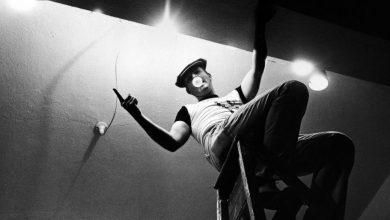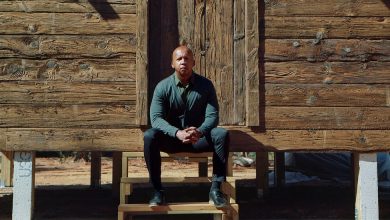An ‘Allegory for Our Times’: The Royal Ballet’s ‘Dante Project’

LONDON — “Be like a jellyfish,” Wayne McGregor said, undulating his upper body expressively. The dancers on the darkened stage of the Royal Opera House on a recent afternoon looked at him for a moment. Then as one, they practiced being like jellyfish. McGregor, the resident choreographer at the Royal Ballet, laughed. “Gorgeous!” he said, moving off to talk to a stagehand who was adjusting the artist Tacita Dean’s huge monochrome backdrop, used in the first part of McGregor’s new and long-awaited “Dante Project.”
The dancers were incarnating the tormented souls of “Inferno,” the opening section of the full-length “Dante Project,” which is to have its premiere on Thursday. With a new score by Thomas Adès and design by Dean — two of the most important artists of their generation — it is among the Royal Ballet’s most significant commissions in recent years, as well as its first coproduction with the Paris Opera Ballet. Expectations, already high, have been amplified by the multiple cancellations and reschedulings since its May 2020 premiere was swept aside by the pandemic.
McGregor began to work on the ballet well before the pandemic arrived. (“Inferno,” was performed in Los Angeles at the Dorothy Chandler Pavilion in July 2019, with the L.A. Philharmonic, a co-commissioner of Adès’s score.) But he was struck, he said, by the relevance of its themes for right now.
“‘The Dante Project’ is almost like an allegory of our times,” McGregor, the Royal Ballet’s resident choreographer, said in an interview backstage. “Some people have literally been through a personal hell, and we’ve all gone through this period of purgatory, of stasis, of not knowing. But also of introspection born out of crisis, working out what it is we want to do next, and hopefully making decisions that will bring us joy and light.”
The idea of making a ballet of “The Divine Comedy” came from Adès, whom McGregor approached in 2014, after using his music for two dance works. “I want a massive piece, three acts,” McGregor told him. In a telephone interview from Paris, Adès said he was immediately intrigued. “The great thing that Wayne offered me was a large amount of time, which is more usual for opera commissions than ballet,” he said. After “batting around” various ideas, Adès thought of “The Divine Comedy.”
“It came into my head and wouldn’t go away,” Adès said. “It goes back to my childhood; I didn’t read it in a scholarly way, but it went right into me then; the physicality of it, the geographical scale of hell. It was quite frightening.”
McGregor, whose movement style is often characterised by hyperkinetic complexity, extreme limb extensions counterpointed against buckling torsos, said that when he read the poem, he was drawn to its vivid physical imagery and beauty. “It offered so many ways in without having to do a direct translation of Dante onstage,” he said. “The poetry is incredible, but dance doesn’t do the words.”
McGregor contacted Dean, whom he had previously approached to work on “Woolf Works.” He is drawn, he said, to her use of different media — she is an accomplished filmmaker as well as a visual artist — but, as with Adès, he didn’t make any suggestions or impose any parameters when she accepted.
“You don’t tell Tacita Dean or Tom Adès what kind of work you want, it’s not that sort of service arrangement,” McGregor said.
Dean, who hasn’t previously designed for the stage, said her initial source was Dante’s text, but she also drew upon visual representations of the Divine Comedy by Botticelli, Blake, Doré and Robert Rauschenberg. “Initially, I possibly went in the wrong direction, imagining making something for a stage,” she said. “I was trying to build something in the middle, then realized it was dance and Wayne needed an empty floor!”
She returned to mediums more familiar to her — drawing, photography and film — to characterize each act. For “Inferno,” she drew negative images on blackboard, portraying the ice and wastes of hell in shades of gray and black (“not easy”) rather than white. “I was working on it for months, writing names on the canvas while listening to American news and Brexit negotiations,” she said. “The corrupt politicians in the ninth circle of hell, they are all in there!” For “Purgatory,” she used a photochemical process to transform the negative of a photograph of a jacaranda tree, looming over a Los Angeles streetscape, into a positive, turning it an unearthly green. And for the final act, “Paradise,” she has created an “entirely abstract and extremely colorful” film.
McGregor said he worked hard at evoking characters in “Inferno,” which has 13 musical vignettes, portraying different groups of sinners: adulterous lovers, hypocrites, thieves, gluttons and Satan, among others.
“Dante describes tortured and tormented bodies, in extreme states of awful physical affliction, and these are amazing anchors for a physical vocabulary,” he said. “How do you make a dance where you have a body with two heads, or show Satan, or the story of the lovers buffeted by extreme wind? That’s been really new for me and quite fun.”
The next two acts are choreographically more abstract, he said, although he incorporated the relationship between Dante and Beatrice, recounted in “La Vita Nuova,” into “Purgatory,” and has depicted the changing relationship between Dante and Virgil.
Edward Watson, a principal dancer who has long been a central figure in McGregor’s Royal Ballet work, postponed his retirement to dance the role of Dante, with Sarah Lamb as his Beatrice. “What Wayne does is give you the range of meaning to find for yourself, through gesture, stillness, fluidity, even a spirituality in the third act,” he said.
Musically, Adès said, he wanted “completely different sound worlds” for each section. For “Purgatory” he drew upon musical material he had long wanted to use: “a special form of prayer that is done before dawn,” originally from the Syrian Jewish community in Aleppo. Now it can only be heard in the Adès synagogue in Jerusalem, which was founded by the composer’s forebears.
“Paradiso,” he added, “is a leap into another world, the world of nature, like one big spiral that keeps going higher and higher until you hear the voices of the angels — or in this case, the London Symphony chorus!”
Writing music for dance, he said, had made him aware that while the mind can move “in mercurial, intellectual directions,” the body is very different. “There is a fluidity, more connection, we are not machines; I had to find a music that thinks like a body, not a mind,” he said. “You allow it to breathe; it’s a very graceful thing to do as a composer, to go in one direction as long as you like.” Besides, he added, “the dancers have to get across the stage and back.”
At the rehearsal, the dancers, dressed in Dean’s chalk-sprayed unitards (“the first time I’ve designed costumes,” she said, “not a place of safety!”) were doing just that, sketching out their steps, getting a sense of the space.
“The dancers have spent so many months not touching each other, not being onstage, it’s a reminder we took all this for granted,” McGregor said. “It’s fascinating to me that the horrific things inflicted on the body in ‘Inferno’ have in many ways happened to people who had Covid.
“We think about our bodies in a different way now, as a battleground of space and touch.” But by the end of the piece, he added, “we have come a very long way from abandoned hope.”
The Dante Project
Through Oct. 30 at the Royal Opera House, London, roh.org.uk. A rehearsal will be streamed live on World Ballet Day on Oct. 19. The ballet can be viewed online from Oct. 29 on ROH Stream.





